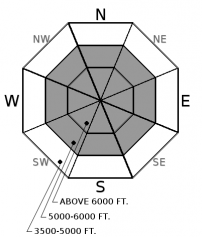| Thursday | Thursday Night | Friday | |
|---|---|---|---|
| Cloud Cover: | Snow | Heavy snow | Snow decreasing during the day |
| Temperatures: | 25 to 30 deg. F. | 10 to 15 deg. F. | 25 to 30 deg. F. |
| Wind Direction: | SW | SW | W |
| Wind Speed: | 5 to 10 mph with gusts of 20 mph | 5 to 10 mph with gusts of 25 mph | 5 to 10 mph with gust of 20 mph |
| Snowfall: | 3 to 5 in. | 7 to 9 in. | 1 to 2 in. |
| Snow Line: |
Whitefish Range
Flathead Range and Glacier National Park
How to read the forecast
Expect changing conditions and rising avalanche danger as another round of heavy snowfall and increasing wind speeds impact the advisory area, forming sensitive slabs and adding weight to buried weak layers. The avalanche danger is CONSIDERABLE at higher elevations and could rise to HIGH tonight. You can find improving riding conditions and a safer snowpack at lower elevations today, but watch for the hazard to change tonight.

3. Considerable
?
Above 6500 ft.
2. Moderate
?
5000-6500 ft.
2. Moderate
?
3500-5000 ft.
- 1. Low
- 2. Moderate
- 3. Considerable
- 4. High
- 5. Extreme
-
Type ?
-
Aspect/Elevation ?

-
Likelihood ?CertainVery LikelyLikelyPossible
 Unlikely
Unlikely -
Size ?HistoricVery LargeLargeSmall

Over the past 48 hours, over a foot of snow has accumulated at mid and upper elevations (up to 2.8” SWE). Heavy snowfall today and tonight along with strong winds will thicken or form fresh storm slabs and increase the sensitivity to human triggers. These slabs will be larger and more widespread at higher elevations or in windloaded terrain. Look for surface cracking, lens shaped pillows, or stiffer slabs as you gain elevation. Most avalanches occur during or immediately after a storm; make conservative terrain choices around terrain traps, steep rollovers, or wind-loaded slopes.
-
Type ?
-
Aspect/Elevation ?

-
Likelihood ?CertainVery LikelyLikelyPossible
 Unlikely
Unlikely -
Size ?HistoricVery LargeLargeSmall

Persistent slabs remain a concern on some slopes and additional loading will test our poor snowpack structure consisting of crust and facets buried below a 2 to 4’ dense slab. These weak layers will be easiest to trigger near rock outcrops and where the snow depth is shallow (generally less than 4 feet deep). This video highlights the problem. Managing the uncertainty is the greatest challenge of a persistent slab problem. If stability is in question, conservative terrain selection in the answer by avoiding steep slopes, especially convexities.
Snowfall came to an end yesterday afternoon providing the snowpack with a short-lived break before our next storm arrives today. 48-hour snowfall amounts range from 11” (2.3” SWE) at Noisy Basin, 2.9” SWE at Stahl Peak, 15” (1.1” SWE) at Pike Creek, and 2.6” SWE at Flattop Mountain. Our last storm system arrived warm and we observed a rain on snow event that reached as high as 5,500 to 6,000 feet. Snow depths rapidly increase with elevation and observations have pointed to sensitive storm slabs along with significant wind loading. These storm slabs fell onto a variety of crust and low-density snow and will continue to thicken today and overnight with additional snowfall. If we get walloped from this fast, potent storm expect both storm and wind slabs to increase in distribution and sensitivity to triggering from the weight of a skier or rider. Evaluate new snow bonding to the old snow surface and look for signs of instability such as surface cracking, collapsing, and avoid wind-loaded pillows on the leeward side of ridges and gullies.
We don't have any evidence yet that our most recent loading events have “waken” our persistent slab problem, but a poor snowpack structure remains in some areas. As long as our poor snowpack structure lingers, it is possible to trigger a dangerous persistent slab avalanche. You can manage this uncertainty by making conservative terrain selections and treating every slope as if it could slide. The recent avalanche fatality in Fernie, BC should be a good reminder that stubborn, persistent slabs can produce large avalanches with grave consequences. I’d be extra cautious in areas such as the Northern Whitefish Range which has the shallowest snowpack in our forecast area, or any area with snow depths less than 4 feet. Give yourself a large buffer around steeper terrain and remember that persistent slabs can be triggered from below or on adjacent slopes.
Cold arctic air retreated east of the Continential Divide overnight, pressure gradient eased, and winds have shifted to the SW at most mountain locations. At 4 am, a stationary front is positioned over northwest Montana with west flow and light precipitation occurring over the Idaho panhandle. Today and tonight a trough and associated low pressure system will move inland and track through the northern Rockies. Precipitation begins around mid-morning on Thursday and ramps up overnight for heavy snowfall throughout our forecast area coming to an end by Friday afternoon. Northwest flow sets in on Saturday with a weak ridge of high pressure forming over the intermountain west. We can expect 1-2' of snowfall by Friday afternoon with highest amounts in the Swan Range.
This advisory applies only to backcountry areas outside established ski area boundaries. This advisory describes general avalanche conditions and local variations always occur. This advisory expires at midnight on the posted day unless otherwise noted. The information in this advisory is provided by the USDA Forest Service who is solely responsible for its content.



























